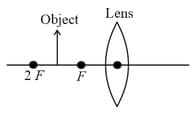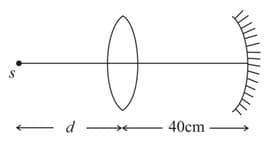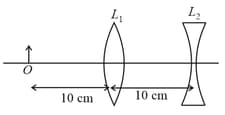The image of an object which is kept at focus of a convex lens is formed at infinity.
Important Questions on Light- Reflection and Refraction
Consider the following statements regarding the real images formed with a converging lens.
(I) Real images can be seen only if the image is projected onto the screen
(II) The real image can be seen only from the same side of the lens as that on which the object is positioned.
(III) Real images produced by converging lenses are not only laterally but also longitudinally inverted as with mirrors.
Which of the above statement/statements is/are incorrect?
In the shown situation, if middle portion of the lens is painted black, then

A converging mirror is placed on the right hand side of a converging lens as shown in the figure. The focal length of the mirror and the lens are and respectively. The separation between the lens and the mirror is and their principal axes coincide. A point source is placed on the principal axis at a distance to the left of the lens. If the final beam comes out parallel to the principal axis, then the value of is:

An extended object is placed at point , in front of a convex lens and a concave lens is placed behind it, as shown in the figure. The radii of curvature of all the curved surfaces in both the lenses are . The refractive index of both the lenses is . The total magnification of this lens system is:


